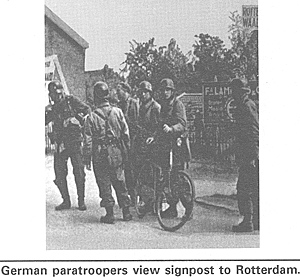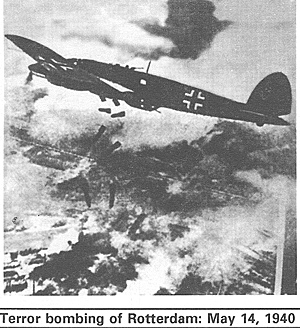 Introduction
Introduction
The Phony War ended on May 10th 1940 when German forces invaded The Netherlands, Belgium and Luxembourg. France and Britain responded by executing their Dyle Plan, sending the cream of their mobile forces into Belgium.
German paratroopers view signpost to Rotterdam.
The Dutch and Belgians followed their own defense plans which were not well coordinated with each other or their new allies. This article and the accompanying scenario are centered on the events that transpired in Holland over the next four days, and what might have happened had the Dutch defense been better suited to the new blitzkrieg.
The Germans
Hitler needed a quick victory in Holland to release troops from the Eighteenth Army for use in France. His generals knew full well that, given the chance, the Dutch could turn their country into a fortress. Plans called for paratroopers and Brandenburger commandos to seize important bridges over which the 9th Panzer Division and other units would pass.
As things turned out the German plans worked, barely. Brandenburgers and paratroopers captured the Maas bridges at Gennep (hex 16A:1121) and Moerdijk (0924), the Waal River bridge at Dordrecht (0823), and one of the main bridges in Rotterdam itself. Similar attempts at Maastricht and Arnhem met with failure.
Crossing at Gennep early, on the 10th, 9th Panzer pushed the Dutch Army north of the Maas. When General Giraud's French Seventh Army reached Breda (0924) on May 11th, the Dutch Army wasn't able to link up. After running into the 9th Panzer near Tilburg (1023) the French withdrew toward Antwerp, leaving the Dutch to fend for themselves. 9th Panzer then turned north, linking up with the paratroopers holding Moerdijk late on the 12th. It was at this point that Holland became isolated, beyond the reach of any meaningful Allied aid.
The Line of Communications (LOC) between Holland and France was severed. Under Fall of France rules, The Netherlands will collapse, and all Dutch units not able to trace supply to a French supply source surrender. Players familiar with Fall of France know that it takes a comparatively small force to ensure the Dutch collapse during the supply determination phase of the May I (regular) German player turn. Most of the German 18th Army can be used elsewhere-it need never be committed against the Dutch Army.
Elsewhere in Holland other German columns were advancing, though not with the speed of 9th Panzer. The Dutch Army gave up eastern and northern Holland without much of a struggle, preferring to stand along the Grebbe Line (0721, 0821, 0921) west of Arnhem. On the 12th, German troops reached the eastern banks of the Usselmeer (Zuider Zee) and Arnhem (0920). SS Regiment Leibstandarte Adolf Hitler penetrated the Grebbe Line at Rhenen (0821) and was quickly reinforced by 207th Infantry Division. A Dutch counterattack made no progress, and soon other units along the Grebbe Line were giving way.
As Dutch units retreated to the eastern edge of Vesting Holland orders were given to flood the area being evacuated. Some 23,000 people an 60,000 animals were successfully evacuated, but the fields were still dry when the Germans arrived.
Major-General Dr Ritter von Hubicki's 9th Panzer (weakest of the Panzer divisions) was joined by 22nd Luftlande Division and other units to form XXXIX Corps under Lieutenant-General Rudolf Schmidt. This force was ordered to break through resistance at Rotterdam and advance through Utrecht to Amsterdam. This maneuver would roll up the Dutch Army and bring organized resistance to an end.
The next morning (14 May) Colonel Scharroo, the garrison commander of Rotterdam, received a surrender ultimatum stating that the city would be destroyed by air and artillery bombardments beginning at 1300. The Dutch High Command's response arrived at German headquarters approximately 1145, fifteen minutes before the ultimatum expired. Although the Dutch hadn't yet given in, General Schmidt postponed the firing and had a radio message sent to delay the bombing by an hour. Unfortunately, many of the bombers had already taken off and never received the radio message. German and Dutch commanders were concluding talks granting the defenders three more hours when Luftwaffe bombers appeared overhead. The Germans fired signal flares to call off the attack, but only a few bombers complied. Most of the force released their bombs on the city, starting fires which were soon whipped into a conflagration by strong winds. Bombs also cut telephone communications with Dutch High Command, leaving Colonel Scharroo to make the fateful decision.
At 1500 he ordered his units to cease fire and stand by. In a meeting with Generals Schmidt, Student and Hubicki, the Dutch Colonel accepted the ultimatum. A second bombing which had been ordered to further convince the Dutch was barely averted when General Schmidt radioed in that Rotterdam had been taken (it had not). Approximately 900 people died from the bombing and fires that destroyed 20,000 buildings in the heart of Rotterdam. Wild claims of 30,000 casualties spread through France, contributing to the panic of her army and populace.
 Terror bombing of Rotterdam: May 14, 1940
Terror bombing of Rotterdam: May 14, 1940
An armistice was signed on May 15th surrendering all Dutch Army units in The Netherlands. Given the hopeless situation and having suffered some twenty-five percent casualties in only five days, any further resistance seemed futile. The government, navy and all troops outside The Netherlands would continue to fight.
The Dutch
The one bicycle and eight infantry divisions of the Dutch Army, along with many smaller units, had been mobilized in plenty of time to meet the expected German attack.
Once mobilized, this force had been tailored to achieve what the Dutch command believed to be their optimum deployment. As an example, the four reserve divisions never operated as such, having their subordinate units used in separate brigades and regiments. The Dutch order of battle from Fall of France places units in their historical locations as of 10 May 1940. The Dutch "free" setup rule in the scenario is included to allow reasonable (but not total) freedom for the beleaguered Dutch. The revised setup and surrender rules should allow the Dutch to fight on past the historical surrender of May 15th.
Dutch defensive plans included a great deal of controlled flooding which was to create a series of water and wetlands obstacles. The flooding was not carried out in any meaningful way due to the rapid German advance and failure of some critical equipment. Had the defenders been given time to react they most likely would have carried out some significant flooding. The scenario rule on flooding is included for use after the surprise turn, should the Dutch avoid an early surrender.
General Henri Winkelman replaced General Izaak Reynders as Dutch Commander-in-Chief in January 1940. Winkelman quickly took some steps to coordinate planning for the expected attack. In addition to placing sealed envelopes containing charts and recognition codes on some warships, a radio link was established between the Dutch and British navies. Further plans were made to have British destroyers escort two chartered merchant vessels loaded with the Bank of Netherlands' gold reserves. This gold had been loaded as early as November 20th in anticipation of an attack postponed by Hitler. When push came to shove these measures proved invaluable in getting the Dutch Royal Family, the government, most of the navy, and yes, even the gold to England.
In game terms it is entirely too easy to take out the Dutch. What if the Brandenburgers failed to seize the Maas bridges? What if Dutch deployments had been altered enough to delay the 9th Panzer allowing the French to make their link-up? Generai Kuchler, commander of the German 18th Army couldn't ignore the 250,000 man Dutch Army. If the thrust by 9th Panzer Division failed to unhinge the Dutch defense he needed to be in a position to storm Fortress Holland. Vigorous attacks by his nine divisions, hundreds of Luftwaffe aircraft, and thousands of paratroopers all contributed to the Dutch collapse. To this end, the revised Dutch surrender terms require a more realistic commitment of German forces to the invasion of Holland. These surrender terms are suggested for use even when playing a standard game of FoF.
For inveterate tinkerers who want to know more, Franklyn Prieskop provided a noteworthy article on the Dutch Army in The Grenadier #12. Additionally, A. E. Goodwin and James Parmenter presented an alternate Dutch order of battle in ETO #55 which reflects much less tailoring than the FoF OB.
Back to Europa Number 27 Table of Contents
Back to Europa List of Issues
Back to MagWeb Master Magazine List
© Copyright 1992 by GR/D
This article appears in MagWeb.com (Magazine Web) on the Internet World Wide Web. Other articles from military history and related magazines are available at http://www.magweb.com